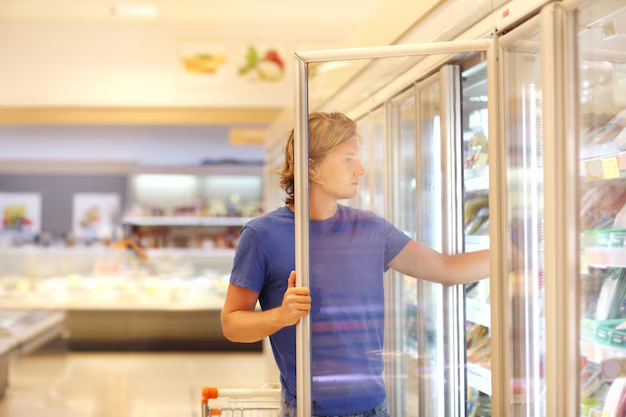Understanding the Optimal Freezer Temperature in Your Refrigerator
When you unpack the groceries from your latest shopping spree, the last thing you want is for your frozen goods to be perishing instead of preserving. While many people focus intently on the refrigerator's cooling settings, they often overlook the importance of maintaining the correct temperature in the freezer section. Proper knowledge of how cold your freezer should be is crucial for both food safety and appliance longevity. Let's dive into the ideal temperature settings and explore various related aspects that can help you achieve optimal performance.
🧊 Why Freezer Temperature Matters
The temperature of your freezer isn't just a number; it's a vital component for food safety. Maintaining it at the right level will:
- Protect Food Quality: Ensure that frozen meats, vegetables, and other perishables retain their texture and flavor.
- Promote Food Safety: Inhibit the growth of harmful bacteria by keeping food consistently frozen.
- Optimize Energy Use: Reduce unnecessary energy consumption by avoiding overcooling.
- Extend Appliance Lifespan: Minimize wear and tear on your freezer by avoiding frequent temperature fluctuations.
📉 What Is the Ideal Freezer Temperature?
Finding the sweet spot for your freezer temperature is straightforward but critical. Experts generally advise setting your freezer to 0 degrees Fahrenheit (-18 degrees Celsius). This temperature is optimal for maintaining the quality and safety of most frozen foods.
Key Reasons for 0°F (-18°C)
- Prevents Bacterial Growth: Freezing at this temperature effectively halts the proliferation of most bacteria.
- Preserves Food Quality: Textures and flavors are more likely to sustain their original properties.
- Minimizes Ice Crystal Formation: Proper freezing reduces ice crystals in foods, which can alter taste and texture.
🛠️ Adjusting Your Freezer’s Temperature Settings
Many modern refrigerators allow you to fine-tune the temperature settings of your freezer. Understanding how to adjust these settings is crucial:
Step-by-Step Guide
- Locate the Thermostat: Most freezers have a control dial inside the compartment.
- Adjust the Dial: Turn the dial towards the colder setting if necessary. With digital thermostats, simply select the preferred temperature using the display interface.
- Monitor with a Thermometer: Place an appliance thermometer in your freezer to cross-check the temperature regularly.
- Fine-tune as Needed: Allow a few hours after adjustments before taking additional readings to ensure accuracy.
🔍 Troubleshooting Common Freezer Issues
Sometimes, even when set correctly, your freezer may not maintain the ideal temperature. Here are common issues and quick fixes:
Issue 1: Frost Buildup
- Cause: Usually occurs when warm air enters the freezer.
- Solution: Ensure the door seal is intact and not worn.
Issue 2: Freezer Not Cold Enough
- Cause: Could be due to frequent door openings or air circulation issues.
- Solution: Minimize opening times and ensure the vents inside are not obstructed.
Issue 3: Unusual Noises
- Cause: Usually an indication of motor or fan problems.
- Solution: Regularly check and, if needed, clean the coils or consult a professional for maintenance.
🔄 Seasonal Considerations for Freezer Settings
Sometimes adjusting your freezer settings seasonally can also be beneficial:
- Summer: With higher ambient temperatures, it might be worth checking that your freezer maintains the 0°F mark.
- Winter: Given colder room conditions, your freezer might naturally maintain its set temperature more effectively, optimizing energy use.
❄️ Practical Tips for Maintaining Optimal Freezer Performance
Keeping your food perfectly frozen isn't just a matter of the right temperature setting. Here are some practical tips to ensure your freezer functions at its best:
- Limit Door Openings: Minimize the time the freezer door is open to maintain a stable temperature.
- Organize Your Freezer: Keeping it tidy can help maintain air circulation, resulting in more even cooling.
- Perform Regular Maintenance: Clean coils, inspect door seals, and defrost regularly if needed.
- Don’t Overfill: Ensure there’s enough space for air to circulate.
📋 Visual Summary: Key Takeaways
Here's a handy guide to remember:
| 🚀 Objective | 📝 Tips & Actions |
|---|---|
| Maintain Temperature | Set freezer at 0°F (-18°C) |
| Preserve Quality | Avoid frequent door openings |
| Optimize Performance | Organize and avoid overfilling |
| Energy Efficiency | Check seals, clean coils, and maintain air circulation |
| Regular Checks | Use an appliance thermometer for accuracy |
🔚 Final Insights
Understanding the optimal temperature and how to maintain it is key to getting the most from your freezer. By consistently applying the principles described in this guide, you not only safeguard your food's safety and longevity but also enhance your appliance's efficiency. Remember, a well-maintained freezer equates to prolonged performance and peace of mind knowing your food is stored safely. Keep these insights handy, and you’ll be well-prepared to keep your refrigerator freezer running smoothly all year round.
